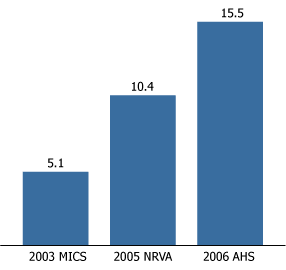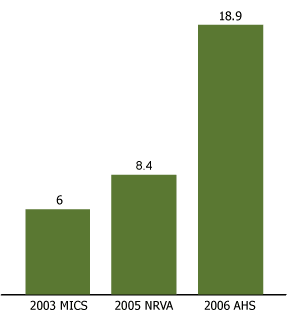
Winds of Demographic Change in Afghanistan?
Date
November 30, 2009
Author
(December 2009) For a long time, Afghanistan has been a country with a high and stable birth rate, a country where women averaged about eight children each, and a country in which one-fourth of its children were likely to die before reaching their fifth birthday. But in recent years, these once-stable trends appear to be changing. Given the extensive and growing media coverage that Afghanistan’s political situation receives, it is important to take a close look at its demographic situation as well.
Afghanistan’s first and only census was conducted in 1979, shortly before the country was invaded by the then-Soviet Union. As a result, there has been considerable doubt about its population size. A census was planned for 2008 but has now been delayed to September 2010, according to the United Nations. The UN Population Division estimates that the population was about 14 million in 1979, but the U.S. Census Bureau puts it at a little below 16 million. The Afghanistan census count was about 13 million. An anomaly in Afghanistan is the reporting of population by sex. Females are underreported relative to males in the younger age groups (below age 15). Son preference is prevalent in the country. Sex-selective abortion is not a likely cause for the underreporting of females, especially given the lack of ultrasound machines. More than likely, some girls are reported as boys since some stigma is attached to families who have only girl children and some families may not wish to report the presence of girls.
Using estimates derived from a number of recent surveys, the UN estimates the current total fertility rate (TFR) at 6.6 children per woman and the U.S. Census Bureau estimates 5.7. Not only do these TFRs, as high as they are, represent quite a decline from the past, but the onset of decline has been quite recent. The real question now is what about the country’s demographic future? The UN has quantified the effect of such high TFRs in its constant-fertility projection. If the TFR remains at 6.6, by 2050 the country’s population would reach 111 million and be growing at 3.6 percent per year, a rate that would double a population in 19 years.
In 2003, the government embarked on an ambitious program, the Basic Package of Health Services (BPHS), to rebuild the country’s shattered health sector and to introduce services to many underserved rural areas where the bulk of the population lives. The delivery of reproductive health services is essential for couples that wish to limit their family size and there appears to have been good progress, judging by contraceptive use rates.
In a 2000 survey, 5.3 percent of married woman used some form of family planning, and 3.6 percent used a modern method.1 By 2003, the percentage had risen to 10.3 percent, 6.1 percent in rural areas.2 In 2006, the reported use of modern contraception had risen to 15.5 percent, a considerable increase in only three years.3 The three most commonly used methods were pills (8.1 percent), injectables (5.4 percent), and condoms (2.2 percent), methods which require a continuing supply. The pill has been the most popular method in every survey taken in the country. Despite the increase, knowledge of contraception remains rather low with only about one in three women saying that they knew of a modern method. Not surprisingly, contraceptive use varied greatly with travel time to a health facility. Among women whose travel time was less than two hours (about 60 percent of respondents), modern usage was 19.4 percent but among women with two hours or more travel time, it was 9.1 percent. About 75 percent of travel to a health center was on foot, reflecting the rural nature of the population and the general lack of motorized transport.
Figure 1
Percent of Married Women Using Modern Contraception in Rural Afghanistan, 2003-2006

Sources: UNICEF, 2003 Multiple Index Cluster Survey (MICS); Johns Hopkins Bloomberg School of Public Health, 2005 National Risk and Vulnerability Assessment (NRVA); and Afghan Ministry of Health, 2006 Afghanistan Health Survey (AHS).
Afghanistan has one of the world’s highest rates of infant, child, and maternal mortality. A lack of antenatal care for pregnant women and low levels of child immunization have been major contributors to this situation. Despite many obstacles, the number of Afghan women who received antenatal care from a skilled attendant (doctors, midwives, and nurses) rose from 5 percent in 2003 to 32 percent in the 2006 Afghanistan Health Survey (AHS). It would appear that the BPHS program has had some success. Distance to the nearest health facility played an important role in the likelihood that skilled care was sought. Women who lived within two hours of a facility (61 percent of all respondents) were almost twice as likely to have had antenatal care. The proportion of women who delivered their baby in a health facility has not risen very much, however. In the 2003 Multiple Indicator Cluster Survey (MICS), only 11 percent of women had an institutional delivery. That figure rose to 15 percent in the 2006 AHS. This is undoubtedly related to the fact that adequate transportation is not available. Pregnant women should also receive at least two doses of tetanus toxoid to prevent their newborn from contracting tetanus. Slightly less than one-fourth of women had done so in 2006.
Figure 2
Percent of Mothers With Skilled Attendants at Delivery in Rural Afghanistan, 2003-2006

Sources: UNICEF, 2003 Multiple Index Cluster Survey (MICS); Johns Hopkins Bloomberg School of Public Health, 2005 National Risk and Vulnerability Assessment (NRVA); and Afghan Ministry of Health, 2006 Afghanistan Health Survey (AHS).
Child health measures have also shown improvement but full immunization remains at a low level. Tuberculosis immunization rose from 57 percent to 70 percent and children with three doses of polio increased dramatically from 30 percent in 2003 to 70 percent in 2006. However, only 27 percent of children had received all recommended immunizations, but that figure was up from 16 percent in 2003.
These figures all point to significant change in Afghanistan, a country that still has the potential for tremendous population growth against a background of poverty, illiteracy, and inadequate health systems. As Richard Cincotta of the Stimson Center has remarked, “population factors, if unaddressed, diminish the possibility that a coherent state, if one emerges, could remain intact.”4
Carl Haub is senior demographer at the Population Reference Bureau.
References
- UNICEF, 2000 Multiple Indicator Cluster Survey (MICS) (New York: UNICEF, 2000).
- UNICEF, 2003 MICS (New York: UNICEF, 2003).
- Afghan Ministry of Health, 2006 Afghanistan Health Survey (AHS). The AHS was taken in rural areas only. The provinces of Helmad, Kandahar, Nuristan, Uruzgan, and Zabul could not be covered due to the security situation.
- Richard Cincotta, “Could Demography Save Afghanistan?” Foreign Policy, accessed online at www.foreignpolicy.com/articles/2009/11/16/could_demography_save_afghanistan.
